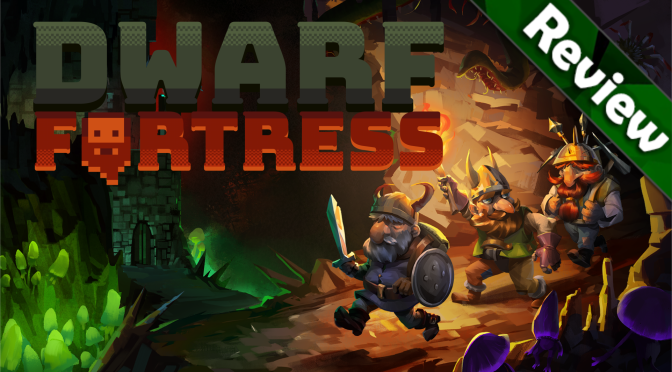Dwarf Fortress has been around since 2006 and I’ve actually been wanting to try it for years, but the ASCII visuals combined with the complexity of the game was somewhat of a deterrent. Although I did consider using a skin pack, I never got around to actually playing it. To my surprise though, a Steam premium version was released with mouse control, a UI and a visual overhaul, so this seemed like a perfect opportunity for me to finally try the game.
I’ve spent around 93 hours with the game so far, and although still consider myself a beginner by all standards, here are my impressions.
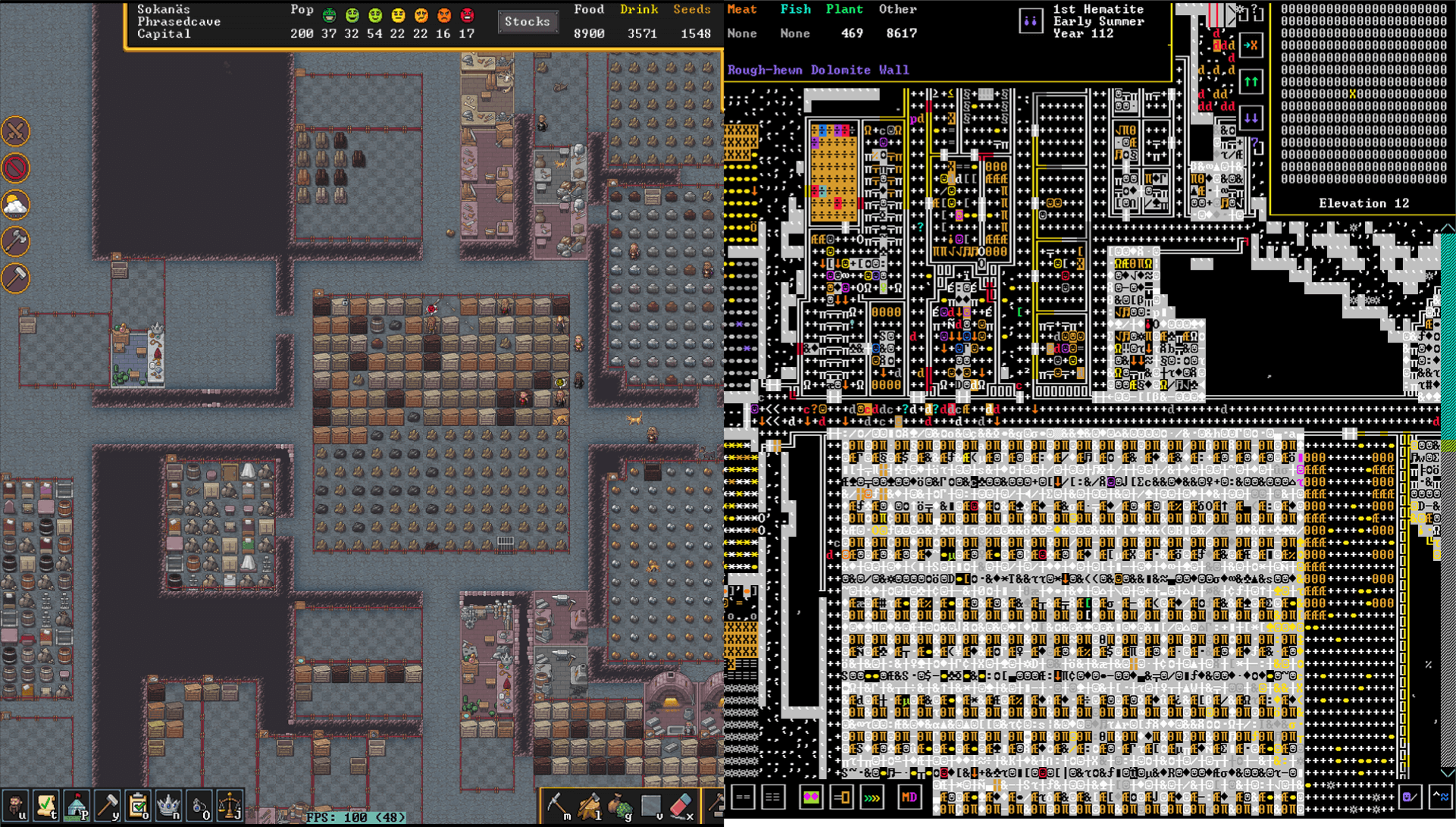
Overview
Dwarf Fortress is at its core a colony management sim, but unlike many other similar games it has inspired over the years, it also simulates the entire outside world and its events (some of which will affect your Fortress and others which will not). You may come across one of the heroes, artifacts or even titans, or perhaps one of your dwarves will be the one creating a legendary artifact that others will try and take. There are endless possibilities for all kinds of emergent stories and events with the way the game generates things, which is great. Outside of this, the game plays as you would expect from a colony management sim. You have a population that you need to feed and keep happy. You mine resources, build up your base, explore, try to survive, and also hopefully prosper for as long as you can, all while dealing with the numerous curveballs the game throws at you.
Dwarf Fortress’s visuals are just a simple representation of what is actually happening, arguably more so than other games of this genre, and don’t reflect most of the details that are going on under the hood. Nothing in the game is animated per se, so units and enemies are just static sprites that move around the play area. This is something to keep in mind. All of its depth and juicy information is found in the combat logs, various descriptors of characters, items, and other stuff (which will require time to read them). So, don’t expect heavy-hitting animations, sound effects or a visual representation of combat. However, I think that having most of the details represented by text offers the ability for it to tell so much more of a story, and give much deeper descriptions of events and items than a visual representation could or even be feasible to do. This of course may not be a plus for everyone.
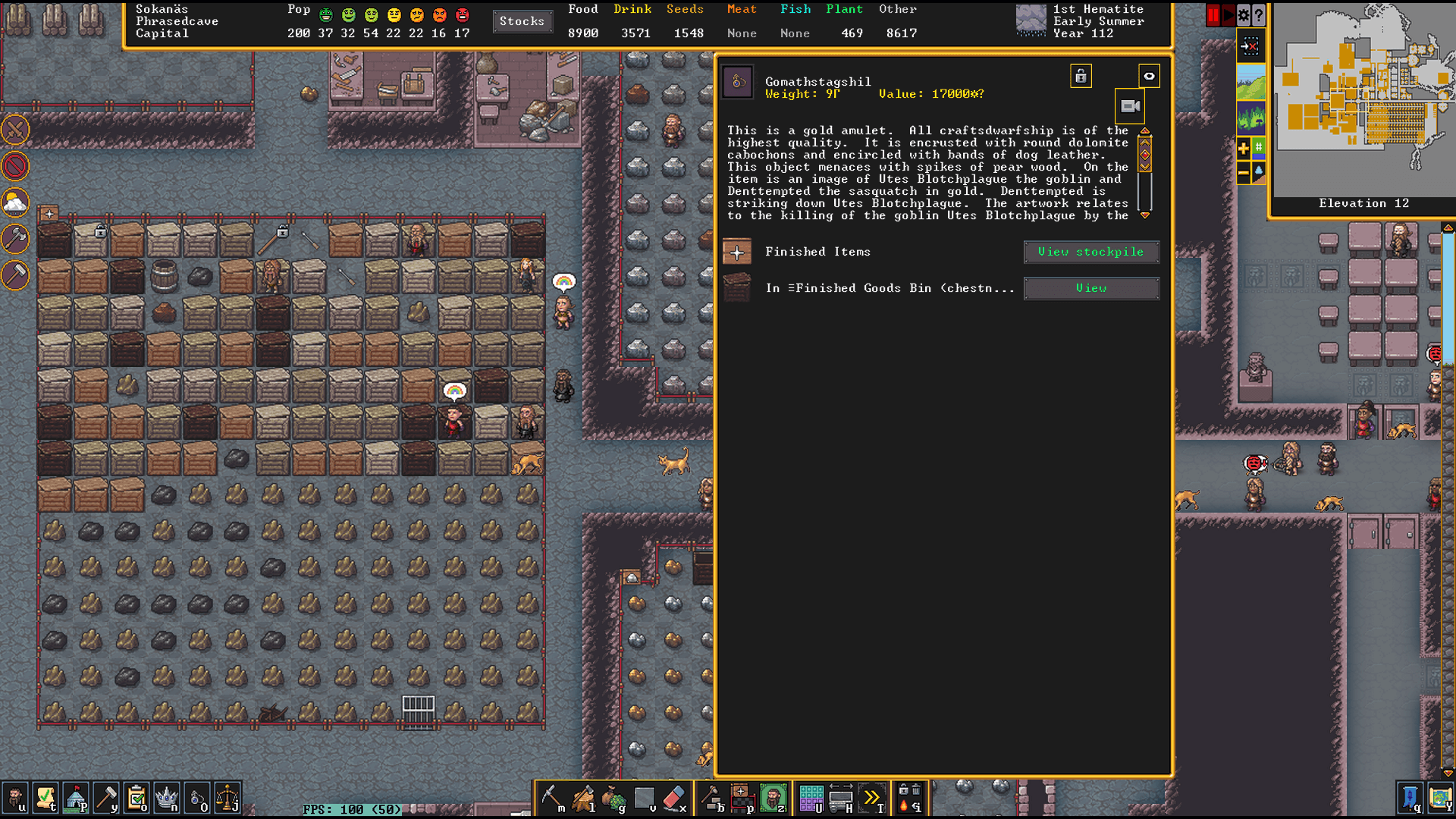
When you start a new game, 100 years of history are generated before the game starts. You can use something called Legends mode to see what has transpired during that time: Historical figures, Sites, Artifacts, Codices scrolls, Regions, Underground regions, Civilizations, Art, Structures and Chronicles. As you can see from the screenshot below there is a ton of information here for you to read, all with colored links to cross-reference events and such. Unfortunately, though, you can’t enter this mode once you’ve actually started your fortress, which is a bit sad. There are workarounds, but it would have been nice to be able to access this while in-game.
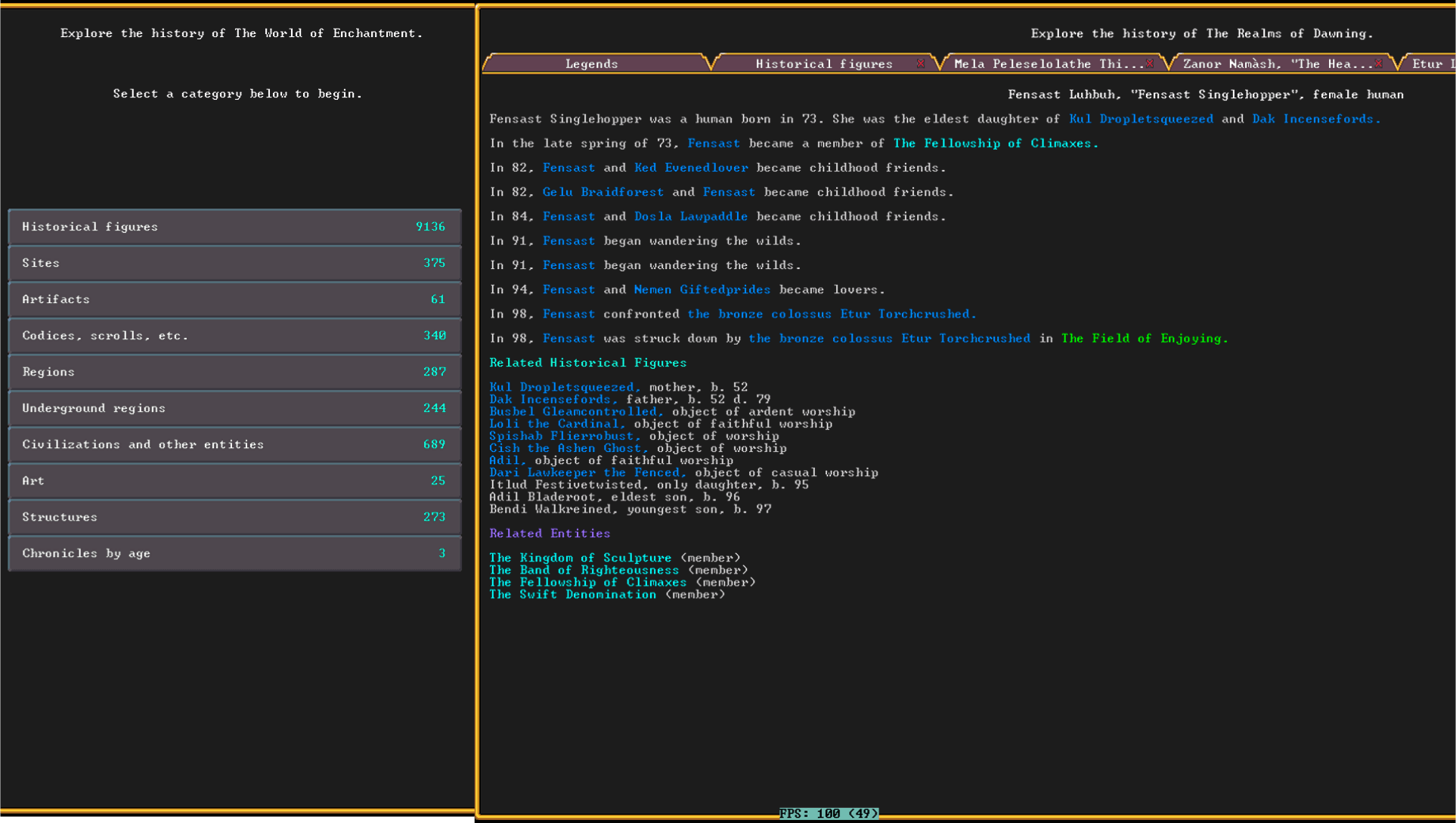
After the world is generated you’ll get to choose an embark location, and can then set a bunch of filters on what areas are preferable for your playthrough. Different climates and wilderness types, along with a variety of other factors, will influence how easy or hard of a time you’re going to have in your playthrough. As with similar games, it’s also possible to set up a custom embark where you choose the equipment and dwarves you start out with.
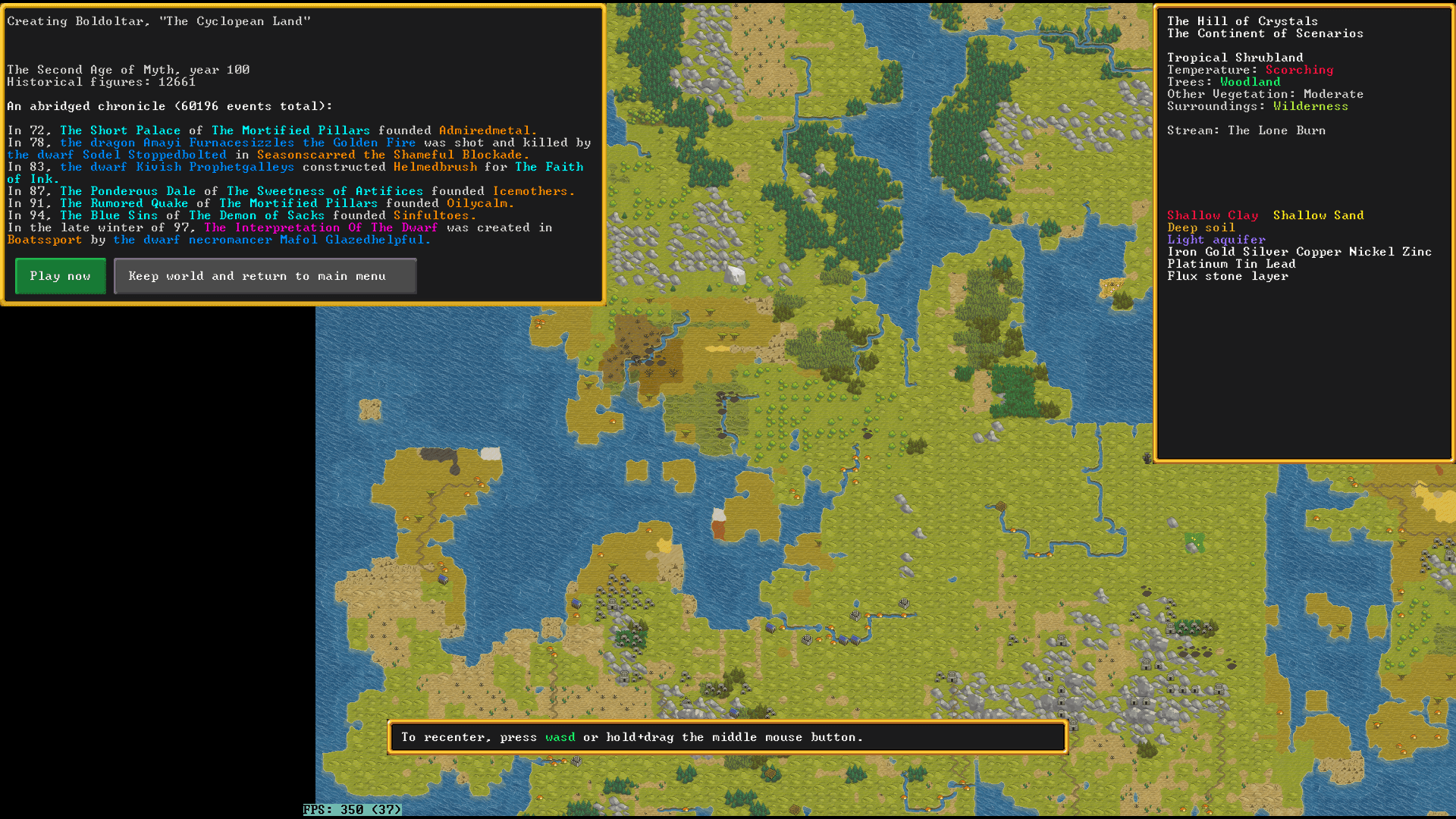
At the start of a new game, you’ll have 7 dwarves, a wagon full of goods/materials, and some livestock (and hopefully a plan). There is a very basic tutorial included in the game that explains some of the systems, but unfortunately, it doesn’t cover nearly enough.
At this point, you’ll start constructing your Fortress, as well as mining out the deep to make spaces for rooms and other parts of your fortress. Assigning everyone to tasks suited to their skill sets, planting both your underground and overland farms, creating breweries for food/drink supplies, building a tavern, carpenters workshops, various metalsmith-related workshops, jewelers and some other workshops along with various stockpiles for storage of all of your goods. This will allow you to grow and maintain your economy more efficiently, as well as construct walls, gates and other defenses to protect your Fortress from dangers.
At the start, you’ll need to manually assign tasks at each workshop. Then, you’ll be able to create an office for both a manager and a bookkeeper, allowing you to track your resources accurately. You will also be able to assign work orders at a larger scale without the need to micromanage each workshop.
There are a number of Noble and administrative positions that unlock as the game progresses, each with requirements that need to be met in order for them to function. When your population reaches a certain size a mayor will be elected. You’ll then need a captain of the guard and a dungeon keeper, militia captains for each squad, a chief medical dwarf for a hospital, and a broker to get the best prices with trade caravans.
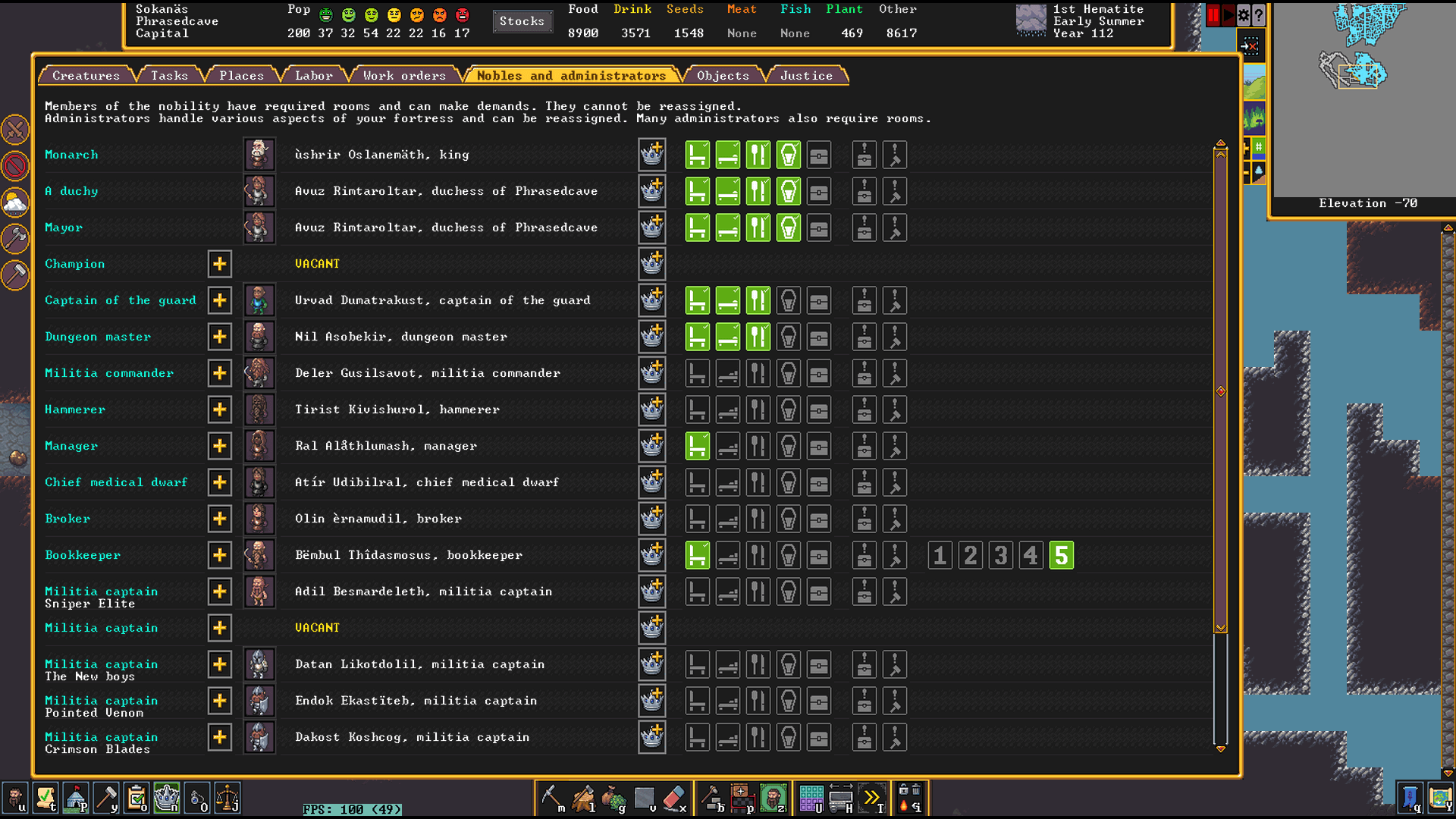
You will also eventually need to train up a more substantial army to defend your fortress from goblin invaders and a myriad of other dangers that lurk on the surface, and in the deeper parts of the earth. Soldiers need gear, so you’ll need to craft these items in your workshops. Just make sure to use your best armorers and weaponsmiths to get higher-quality gear (that offers better bonuses). You can assign each squad with general or very specific gear, set up a training schedule, patrol routes and the like. Needless to say, soldiers can get injured and killed so having a hospital with doctors skilled in various disciplines is necessary (diagnosis, surgery, bone doctor), along with keeping your hospital supplied with splints, bandages and soap to clean wounds, and making sure it has enough beds and a traction bench.
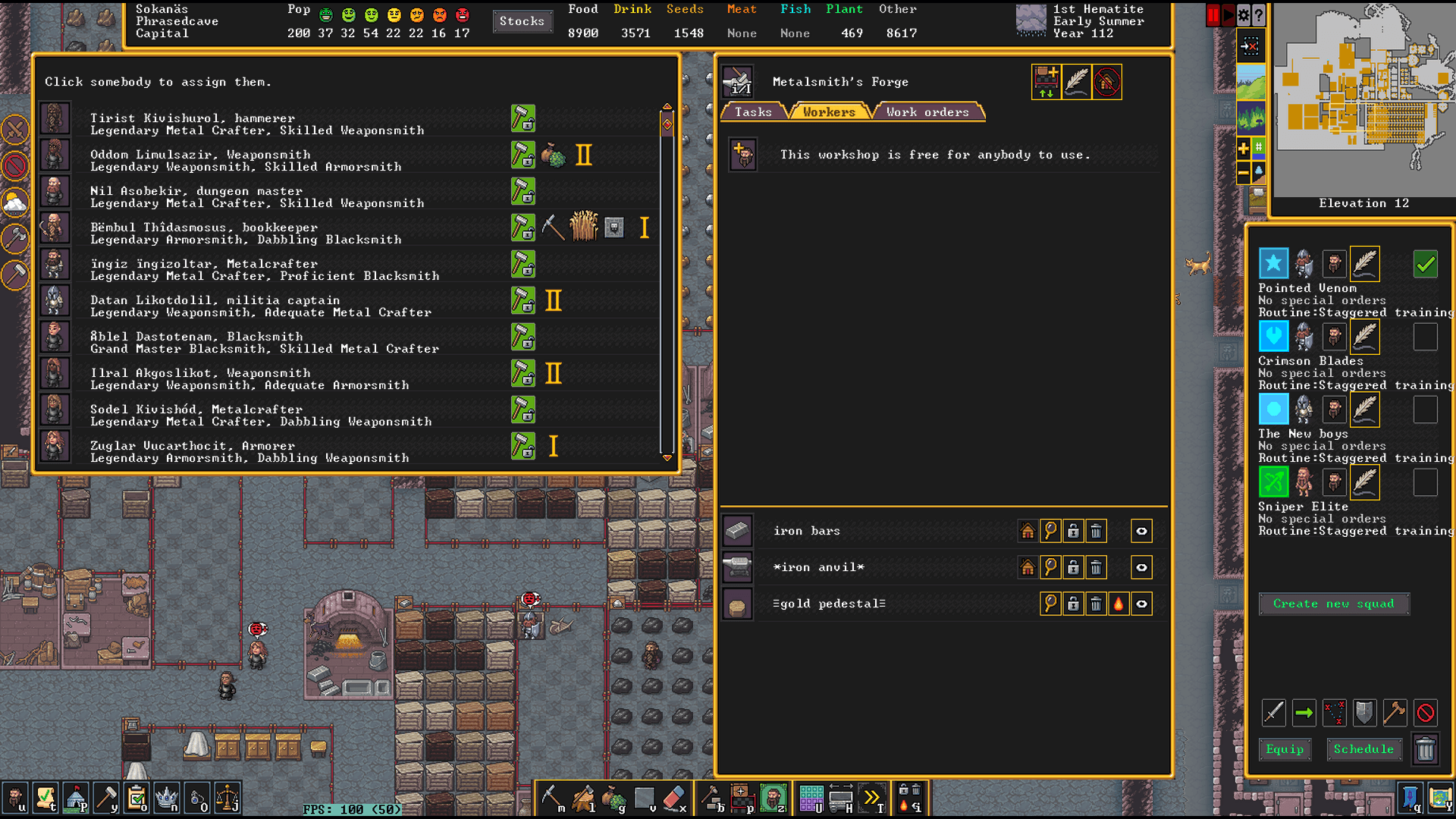
You’ll need to keep your dwarves happy as well. Every dwarf has a personality, wants, needs and memories. Good events will add to their mood, whereas events they don’t like will reduce it. Some events will remain in their memories and affect the rest of their lives as well. There is a lot of detail here. Improving rooms with fancy items, engravings, adding entertainment at the tavern or temples to whichever deities they worship, assigning them to jobs they desire, establishing guilds for groups that request them, and having them spend time with friends and family will all improve their moods. There is a fair amount to keep track of, but the happier your dwarves are, the fewer issues you’ll have.
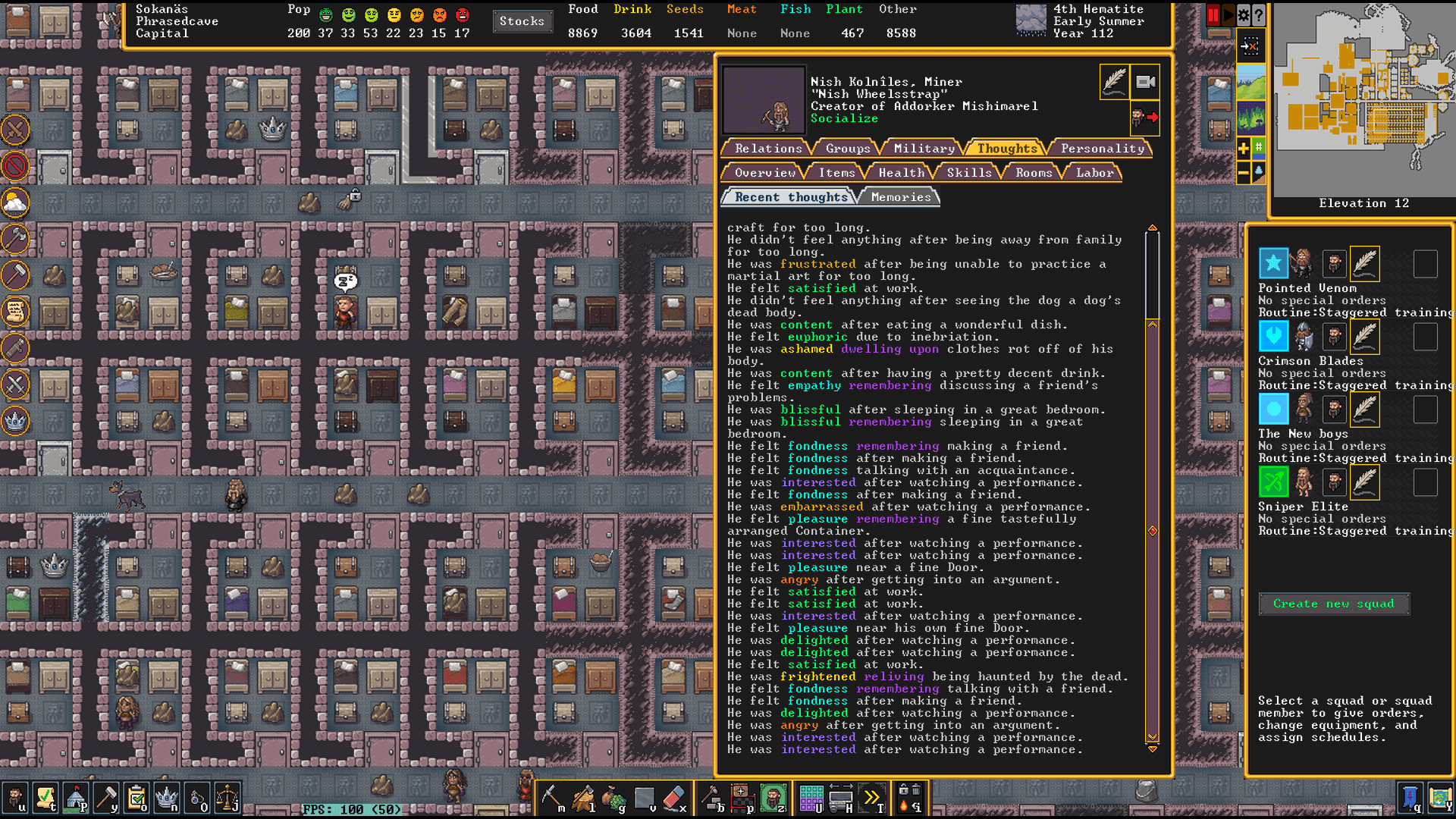
Unhappy dwarves will start causing trouble, breaking things, starting fights and being a general nuisance which affects those around them, or even refuse to eat or drink. Regardless of how well you manage things, inevitably, there will always be some discontented citizens. You’ll need to build a dungeon, appoint a dungeon master and a captain of the guard to deal with these troublesome elements. This allows you to interview the witnesses to each crime and eventually convict these dwarves and send them to the dungeon for a time.
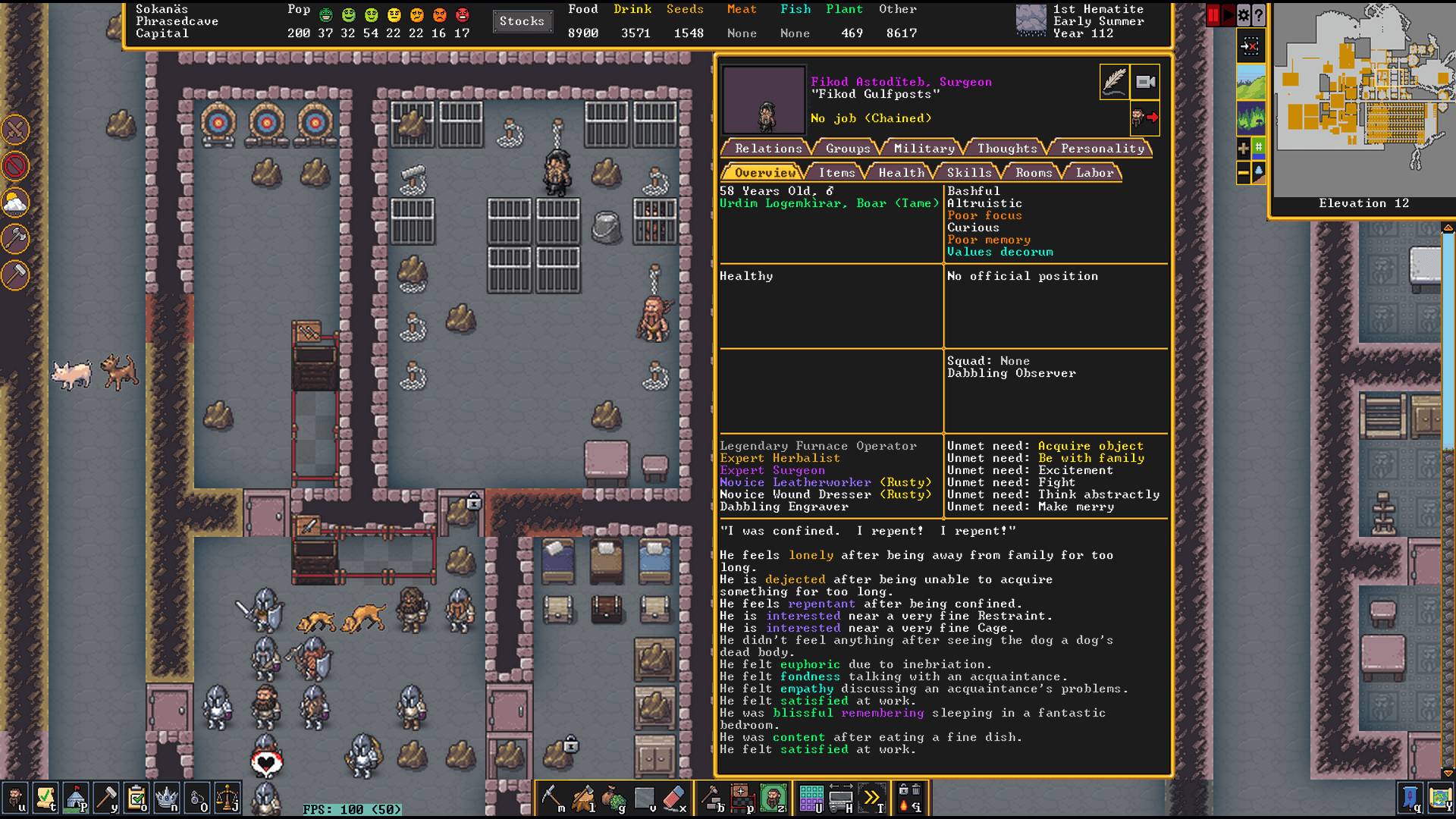
While all this is happening you’ll be expanding your fortress, mining deeper and deeper in search of valuable ore to make jewelry or items to sell and increase your renown, and metal ores to improve your weapons and armor for tougher enemies. Digging deep enough will eventually uncover caverns that contain all kinds of valuable resources, but also a number of dangerous enemies. These locations are better places to have your underground farms than the mud/sand/clay layers, but come with their own risks. Digging even deeper will uncover magma and a host of other perils. As the distance increases for all your mining, you’ll also be able to build a minecart network to transport goods more efficiently as well, which can eventually be powered.
The population soft caps at 200 dwarves by default, up to 220 with kids. This amount can be increased or lowered in your options screen to your preference, but increasing it could have an impact on your framerate.
The game can be paused at anytime, otherwise it’s speed is connected to your frame rate. You can increase and decrease your frame rate to affect the game speed with hotkeys, but there is no way to jump to a particular preset speed which is a pity, a few simple presets would certainly be welcome addition as opposed to the system that is currently in place.
Combat wise, not much is visually shown as I alluded to earlier, some blood splatters, or corpses, but it is quite descriptive textually, and if you really want to delve into details you’ll need to check the text log of events and the character info to see how a unit is doing and what injuries they’ve received. As with everything else in the game, the depth is in the text. None of this detracts at all from the experience, at least for me, I quite liked it, but it may not be to the liking of some players.
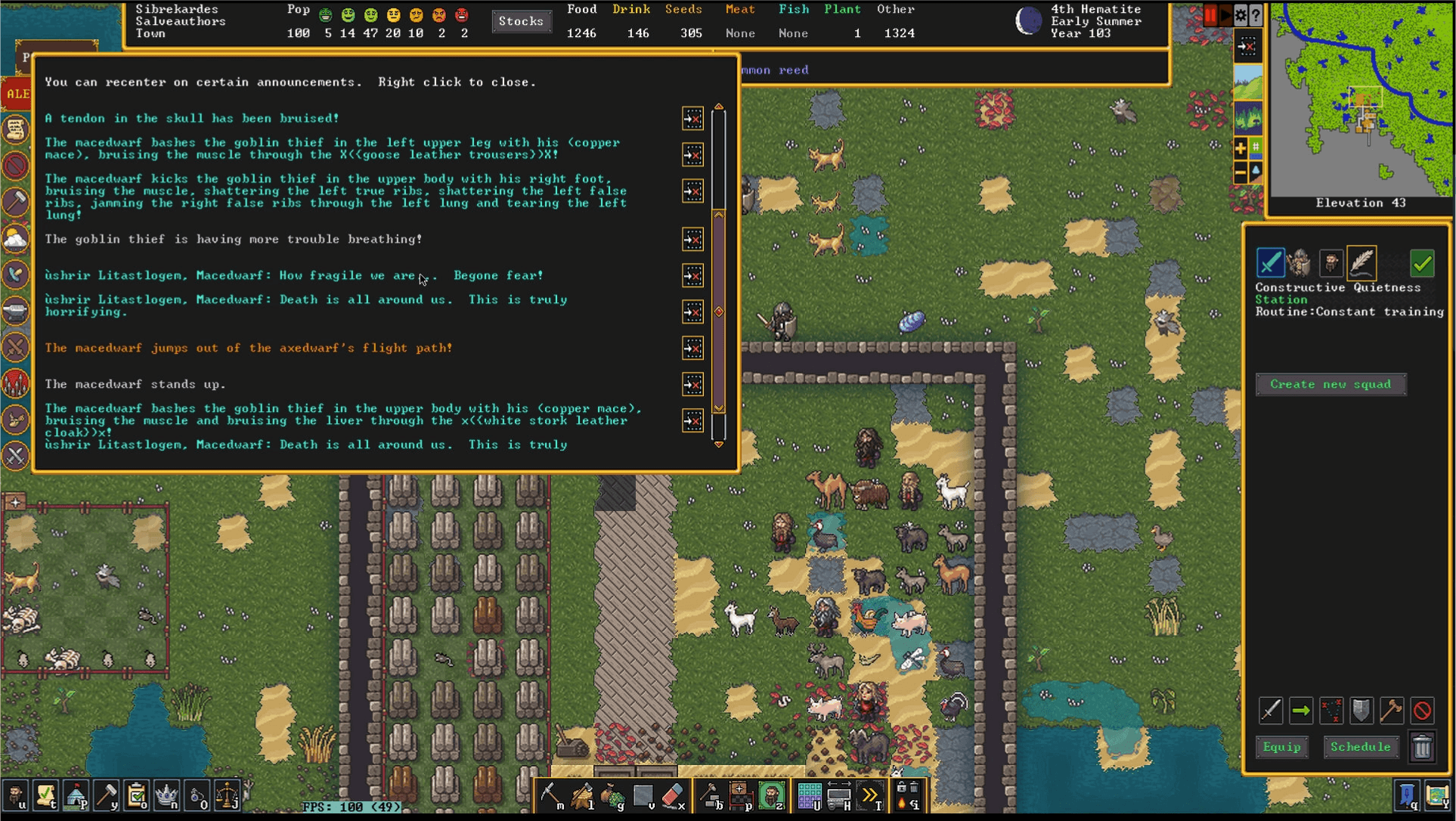
There is a world map as well where you can get some information about what’s happening around you, send your squads on raids, rescue missions, missions to get artifacts etc. You don’t get to see these events, but can read about their failure or success from this window, along with other information like what trade agreements you currently have and news and rumors, amongst other things.
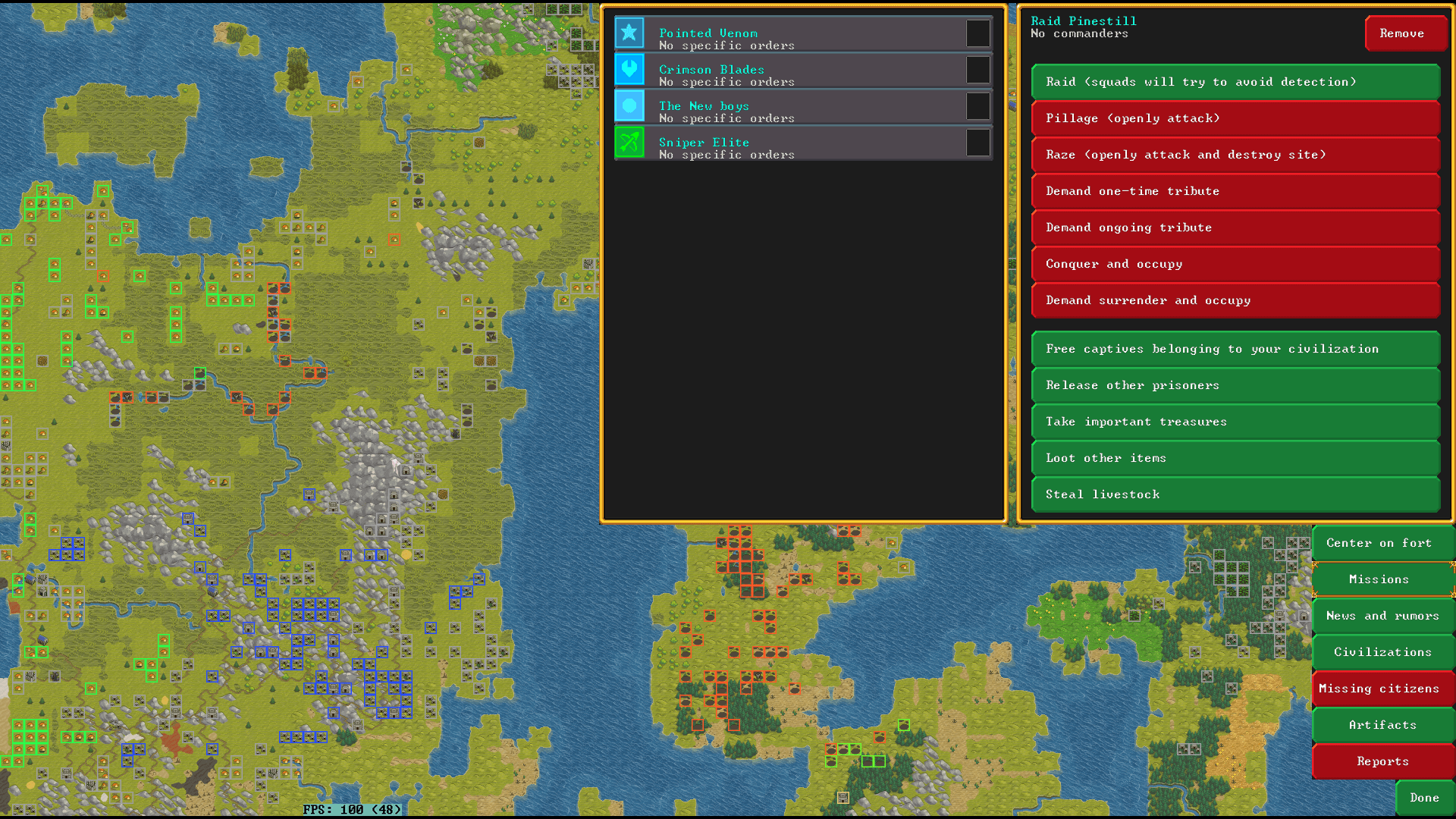
Dwarf fortress is all about stories, and you find plenty of them all over the internet. Some really crazy stories for sure. These emergent stories come about because of the way stuff is generated and plays out in the world you create.
In my main game my dungeon master of all people got convicted for causing trouble, just a few months after he was appointed to the position. Perhaps I chose poorly….at any rate, after he’d been convicted and was being led to his cell and it seemed he killed himself. Well, at least that’s what I think happened, unless someone murdered him, I can’t quite be sure.
And at some point a swamp titan decided to wander into my zone, it was a tough fight. I lost an entire fully armored squad, and this things AOE fire attack decimated the entire woodland, causing a wood shortage for months.
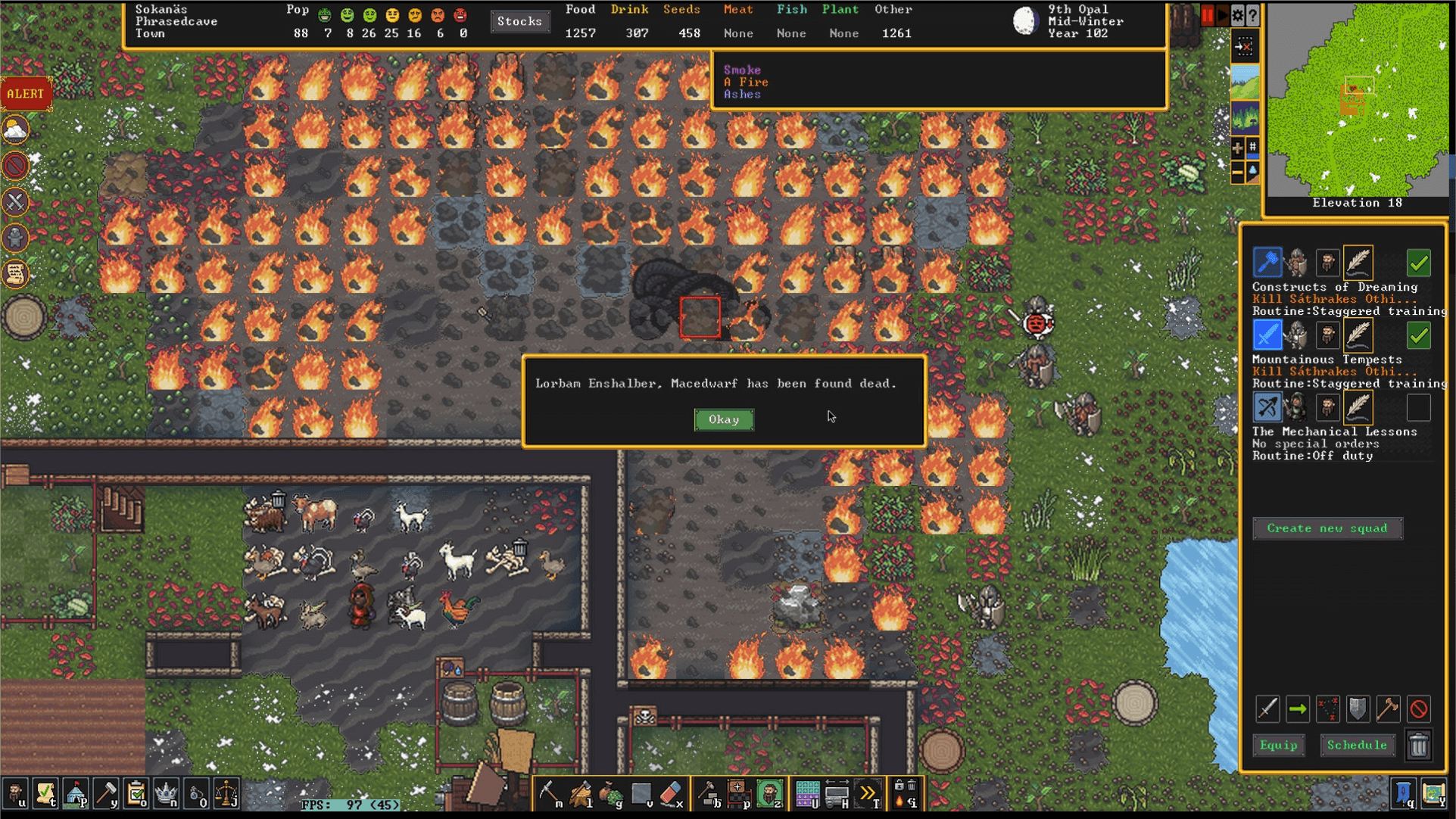
Despite various setbacks, my fortress became quite successful. After about 8 years my civilization decided to make it the capital after which the King moved in. Naturally, he demanded the fanciest room I could make (gold and jewel encrusted furniture, a large room, gold statues and the like), and then of course started to make mandates on what I could and couldn’t craft.
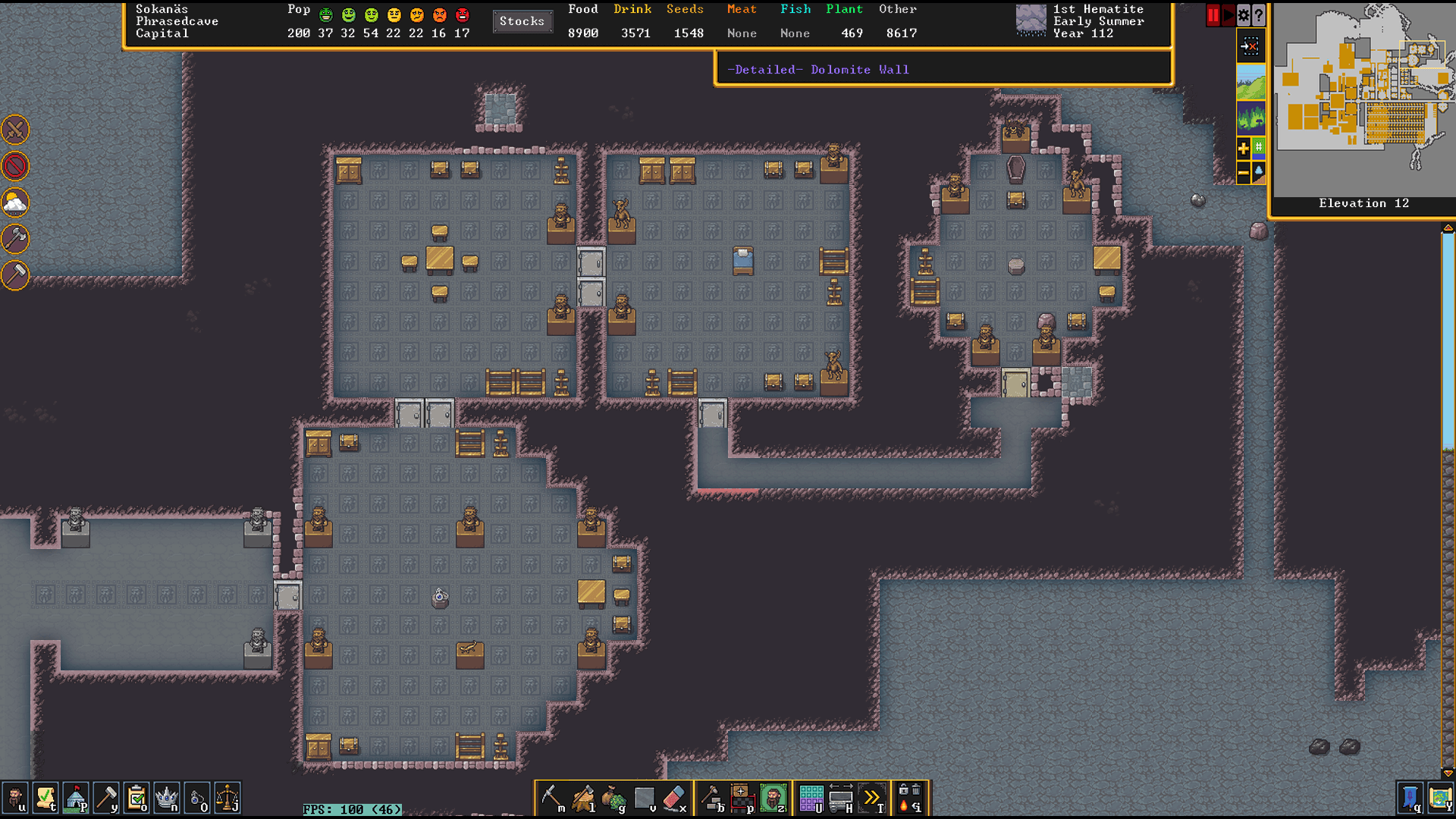
Issues
There are unfortunately a number of issues with the game at the moment.
The first and most serious are the crashes that plagued my main playthrough. These would happen randomly every season or two causing me to lose all the progress up until that point. While this can be remedied by manually saving the game frequently, one doesn’t always remember to do this when deeply invested in running the fortress. The game only autosaves every 3 months (at the most frequent setting), and there is no way to quick save, or set the frequency of autosaves to a weekly or monthly basis. Saving takes a while, so it can be quite interruptive, but not as much as losing 3 months of progress I suppose. I do hope they add more options for autosave frequency.
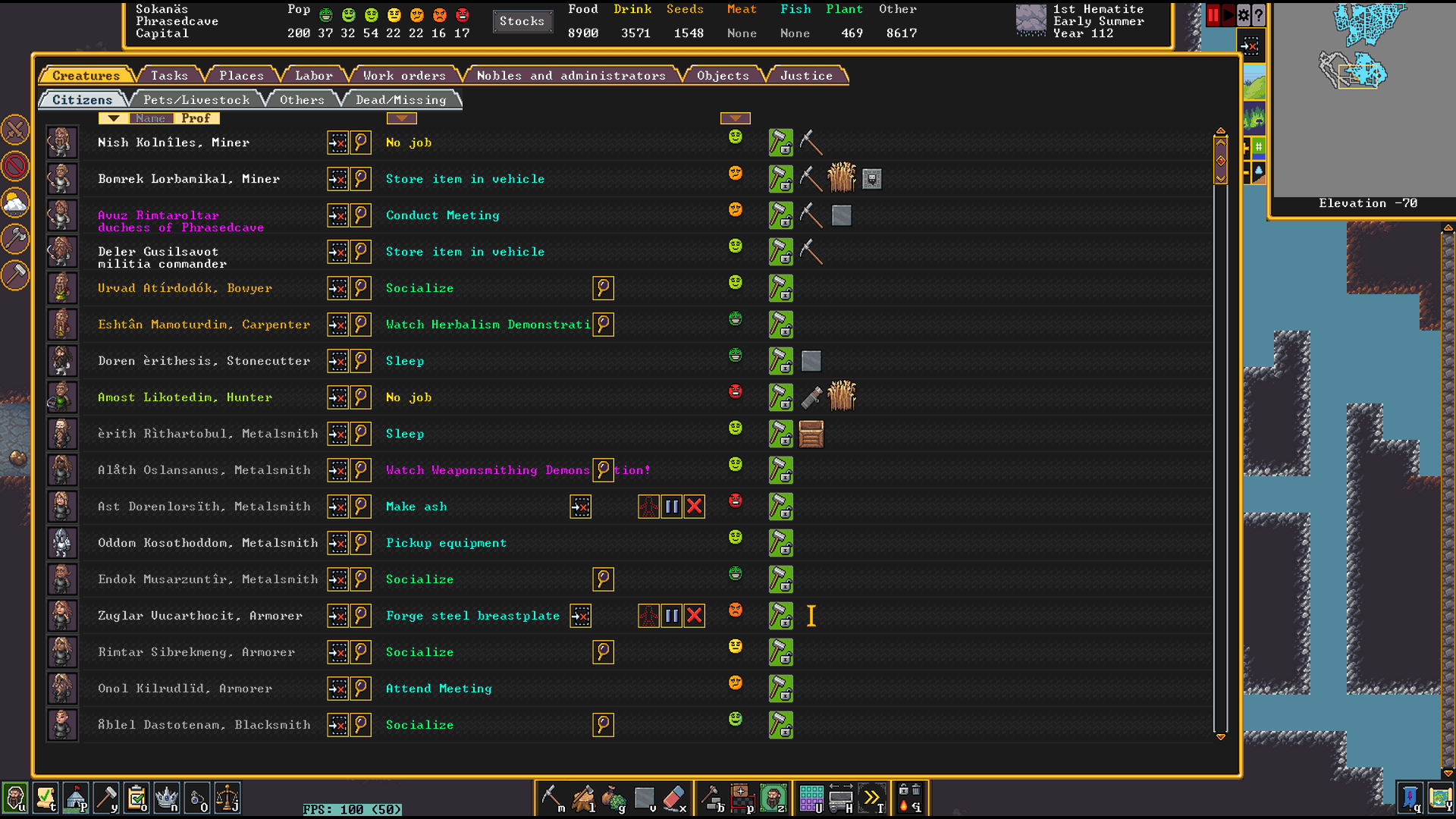
The second biggest issue is the UI. While it’s nice that the game has a UI, it is incredibly cumbersome and a chore to get through. It’s impossible to easily go back and forth between menus when checking on your dwarves for example. No colored links similar to Legends mode (which is odd). You need to exit the entire menu, open the dwarf menu again and look through the list, and scroll down to the next dwarf you want to check every single time.
Another example is when scheduling witness interviews you click on the law tab, select schedule interview, then you are presented with a confirmation button, once that is done you are taken back to the main list at the top. So you’ll need to scroll through the entire list again to get the ones that you have not yet selected each and every time. You’ll be doing this for every single new offense and it becomes incredibly tiresome when you have large population. There is no way to schedule all interviews with a button click. Why?
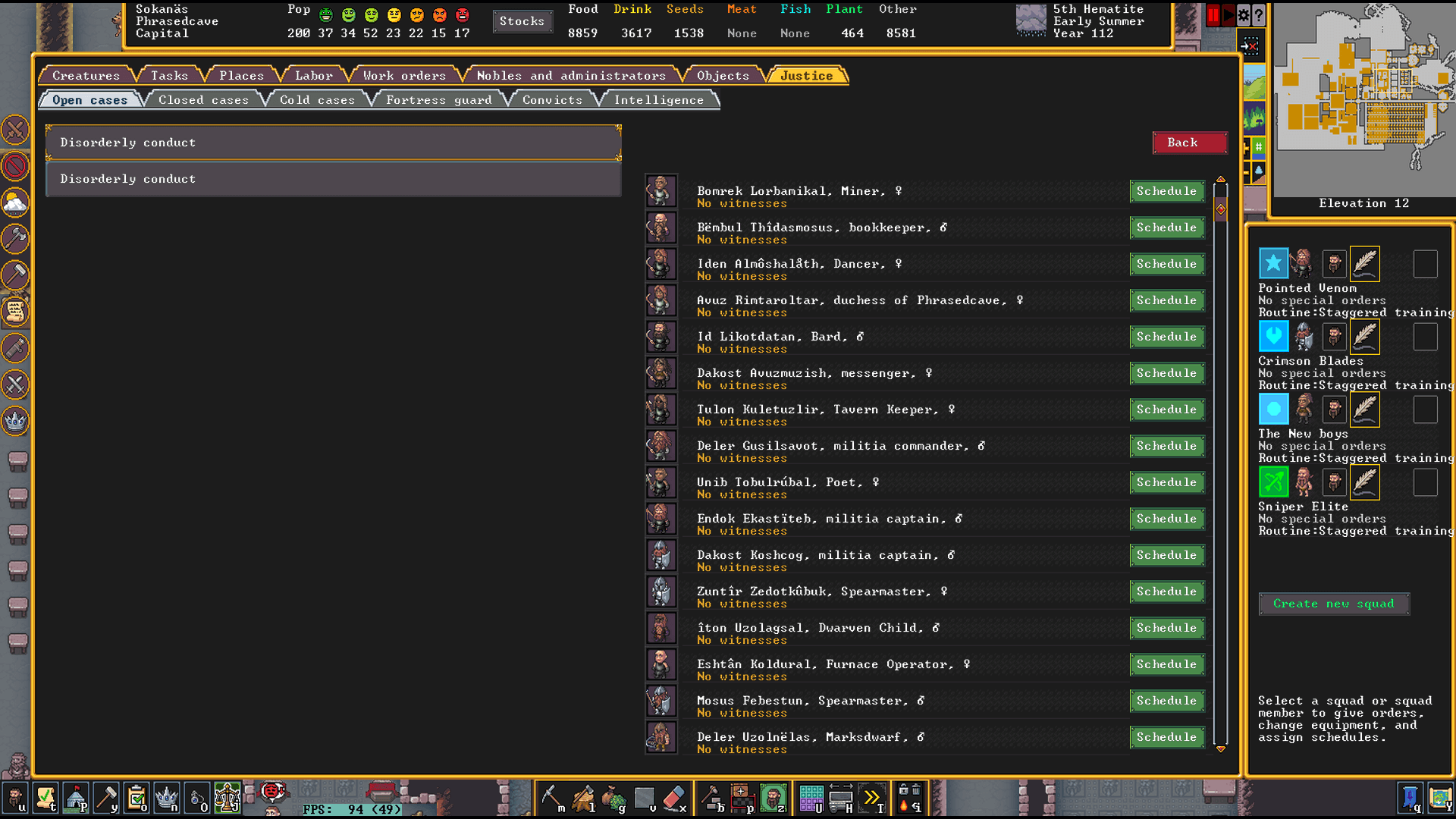
The entire UI suffers from these types of issues which is unfortunate. This game presents so much information and there are so many complex systems here that there absolutely needs to be a more streamlined and easier way to access this information. I really hope this gets improved.
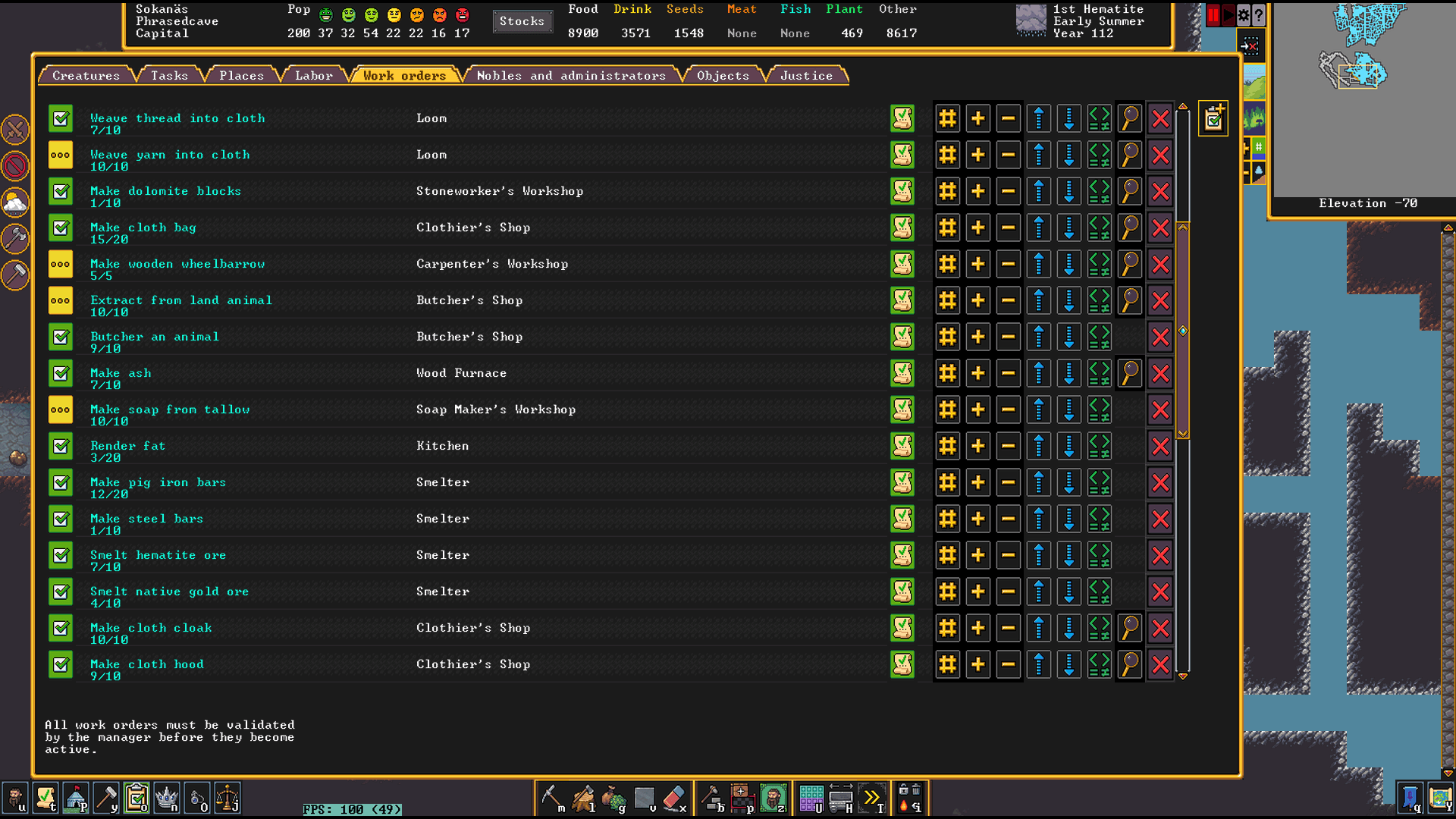
Finally, there are a fair amount of bugs. In one of my games, dwarves just did not move the corpses in the base at all despite having relevant stockpiles, and these items were not locked. As a result, miasma started spreading around my base making my residents unhappy.
Dwarves being unable to wear foot armor because they won’t put it over their socks, unless you create a specific template to do so, issues with archers not using ammo or stockpiles in some cases just are not functioning the way they should despite being set to accept only specific items or have workshops only take from or deliver items to them.
I’ll admit that some of the other issues I experienced were due to the game not explaining how some systems worked and me being completely new. In one of my games my dwarves had no option to craft high boots of any kind. It took me asking on the forums, since I thought it was a bug, to find out that occasionally there are certain items your civilization will not be able to craft. Of course the game does not inform you of this in any shape or form.
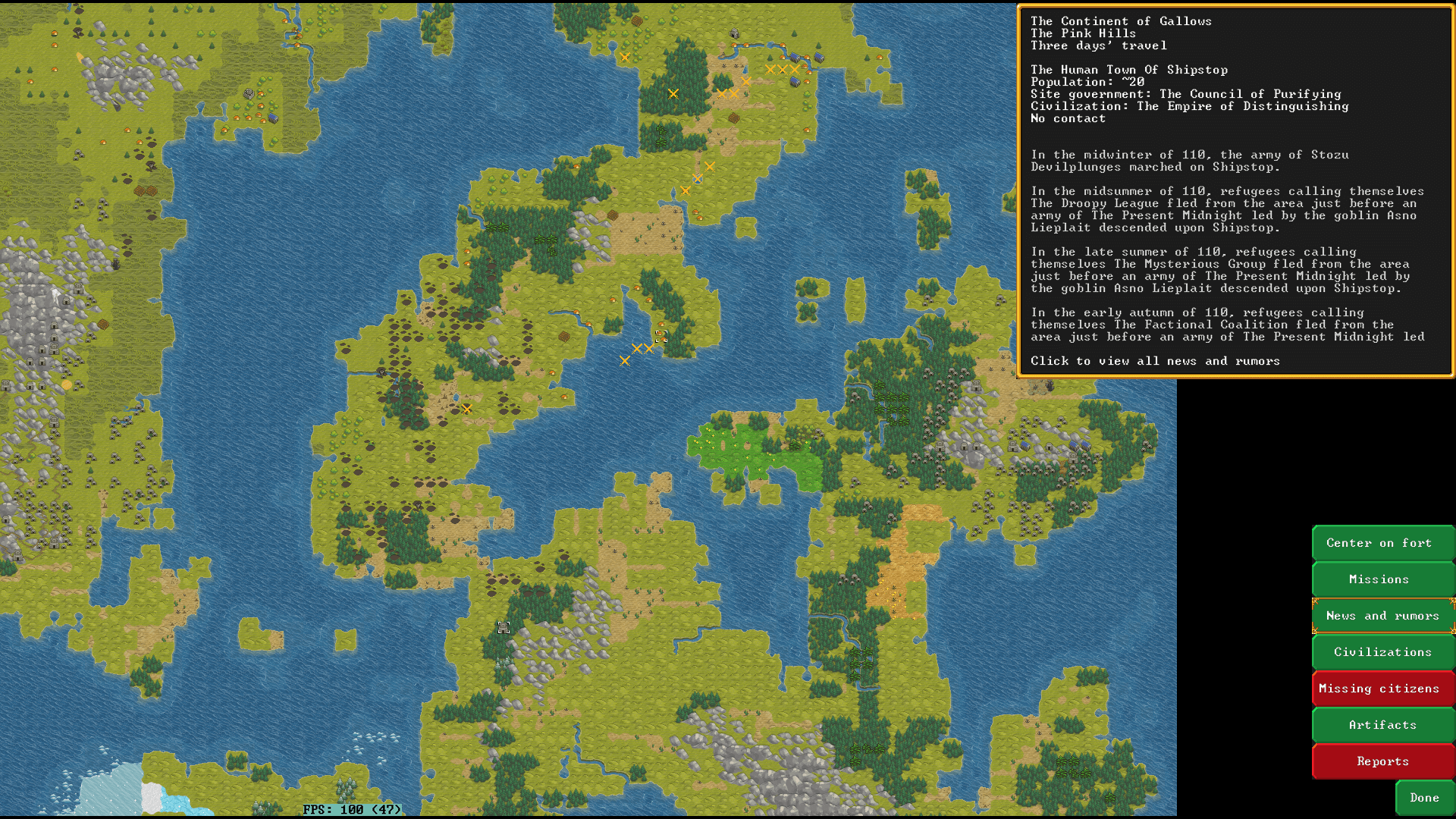
The tutorial is incredibly barebones as well, and even when combined with the informational tool tips that are currently provided, it at best it fails to really prepare you for the depth of the game, and at worst doesn’t actually tell you anything about some of the mechanics at all. If you want to get the most out of the game you will need to check the wiki, read some guides and watch some video tutorials by more experienced players if you hope to understand some of these more convoluted, poorly explained systems.
While these issues don’t make the game unplayable, the crashes and bugs in particular can certainly hinder the enjoyment of the experience. There is a great post on the steam forums regarding some improvements that could be made, I’m not going to go into them here since it’s quite a long list, but you can read them yourself here.
The game does support the mods, there are already plenty to be found on the Steam workshop which is great. No doubt some of these will at least address some of issues that are present in the game.
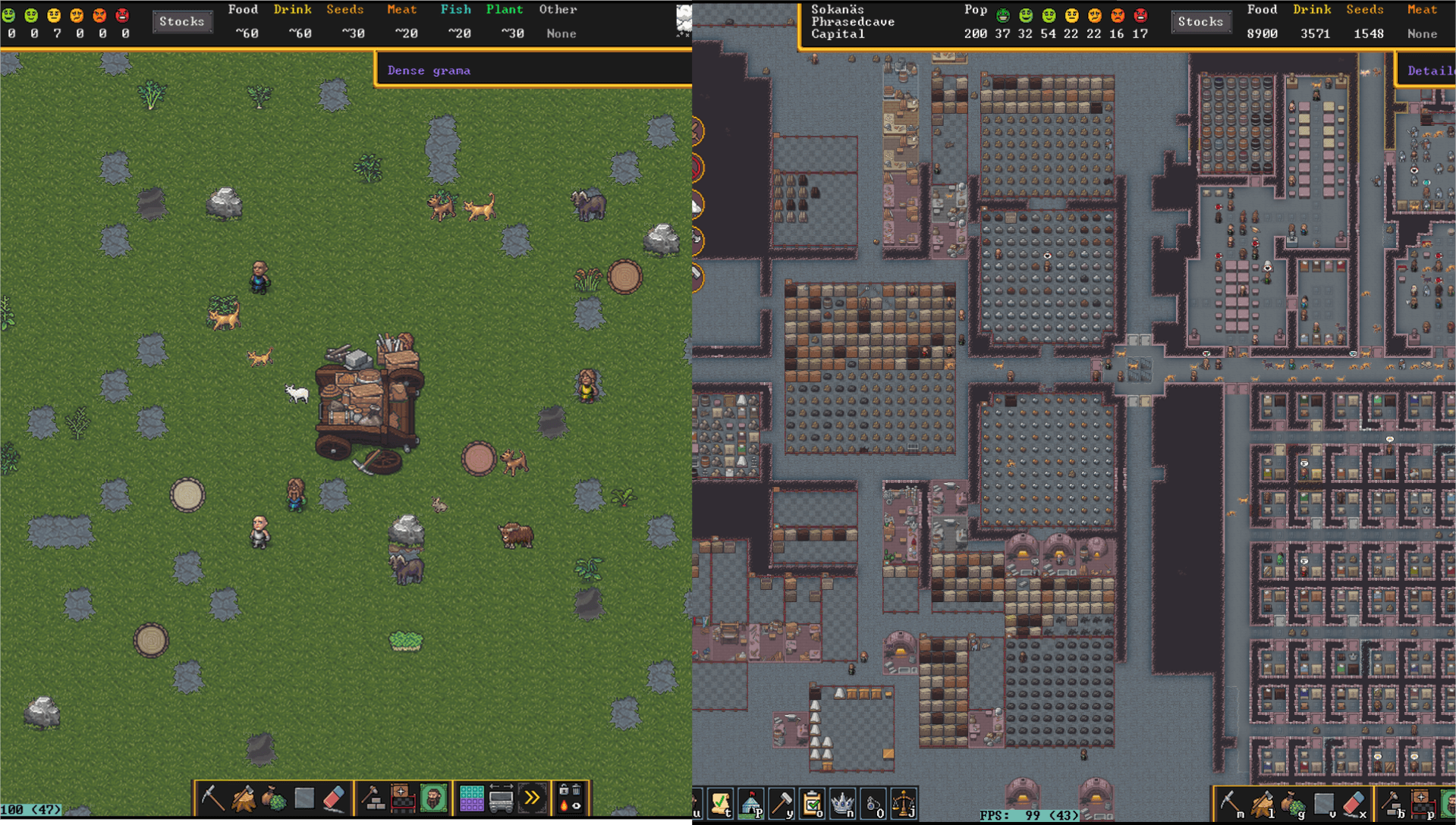
Conclusion
It was impossible for me to cover all of the game’s systems in this review since there are so many of them and it would turn this review into a novel. As a new player, I still have a lot to learn, and I’m most certainly only scratching the surface.
What I can say though, is that Dwarf Fortress is a fantastic game, if you have the patience to learn it. I’m also very happy that the Adams brothers decided to release a more accessible version of the game that would give players like me a chance to play it.
However, the UI needs a serious overhaul in almost every aspect, and the tutorial along with the way the game presents information also need a lot of improvement. When comparing these areas to something like Rimworld for example, it just highlights the weaknesses of this UI as far as accessibility and ease of use go.
Obviously, this doesn’t make Dwarf Fortress bad but rather just frustrating to navigate, and this could put some people off. Regardless of these issues I absolutely loved my time with the game and was itching to play more.
As a colony management game, this is one of the best out there. It’s incredibly deep, and the world generation along with its ability to create crazy emergent stories is superb. I don’t think the asking price of €30 is too much. However, I hope that with the success of the Steam sales they’ll be able to release more frequent updates, work on the UI and add QoL updates down the line.
![]()
- Incredibly deep
- More accessible
- Very addictive
- Replayability
- World simulation & scale
- Emergent stories
- Workshop/Mod support
![]()
- Steep learning curve
- UI needs improvement
- Barebones tutorial
- Bugs & Crashes
Computer Specs:
Windows 10 64-bit computer using an Intel i7-12700k, 32GB Ram, and an nVidia RTX 3080 graphics card.
Stephen is our resident kung fu master and reviewer. When he’s not kung fu fighting, he’s playing games, and has been since the atari 2600. He also runs his own YouTube channel called Particular Pixels, where he creates a variety of content related to PC gaming. He goes by the nickname Shaoling (not to be confused with Shaolin), which comes from his favorite PC game of all time, System Shock 2.

